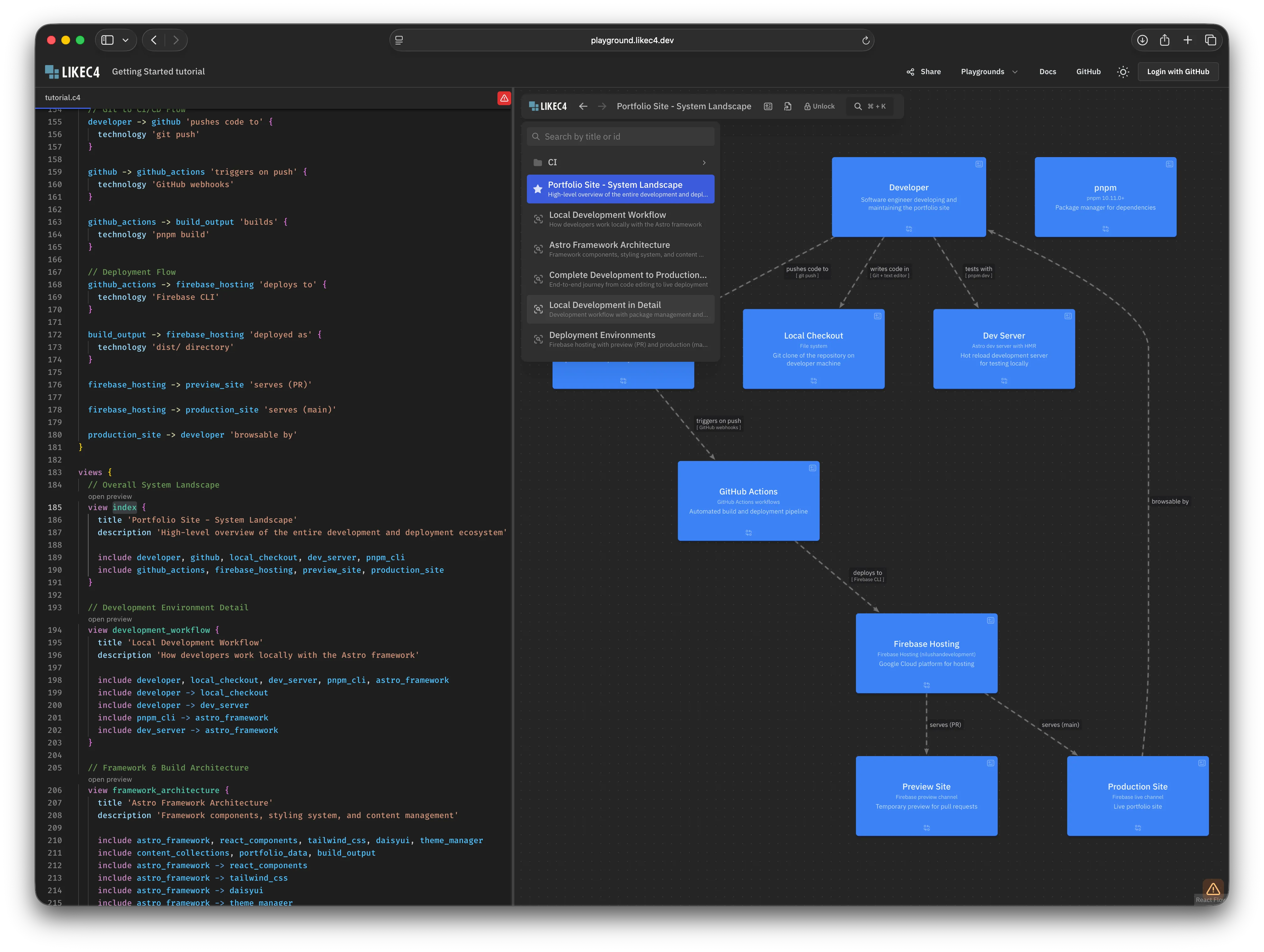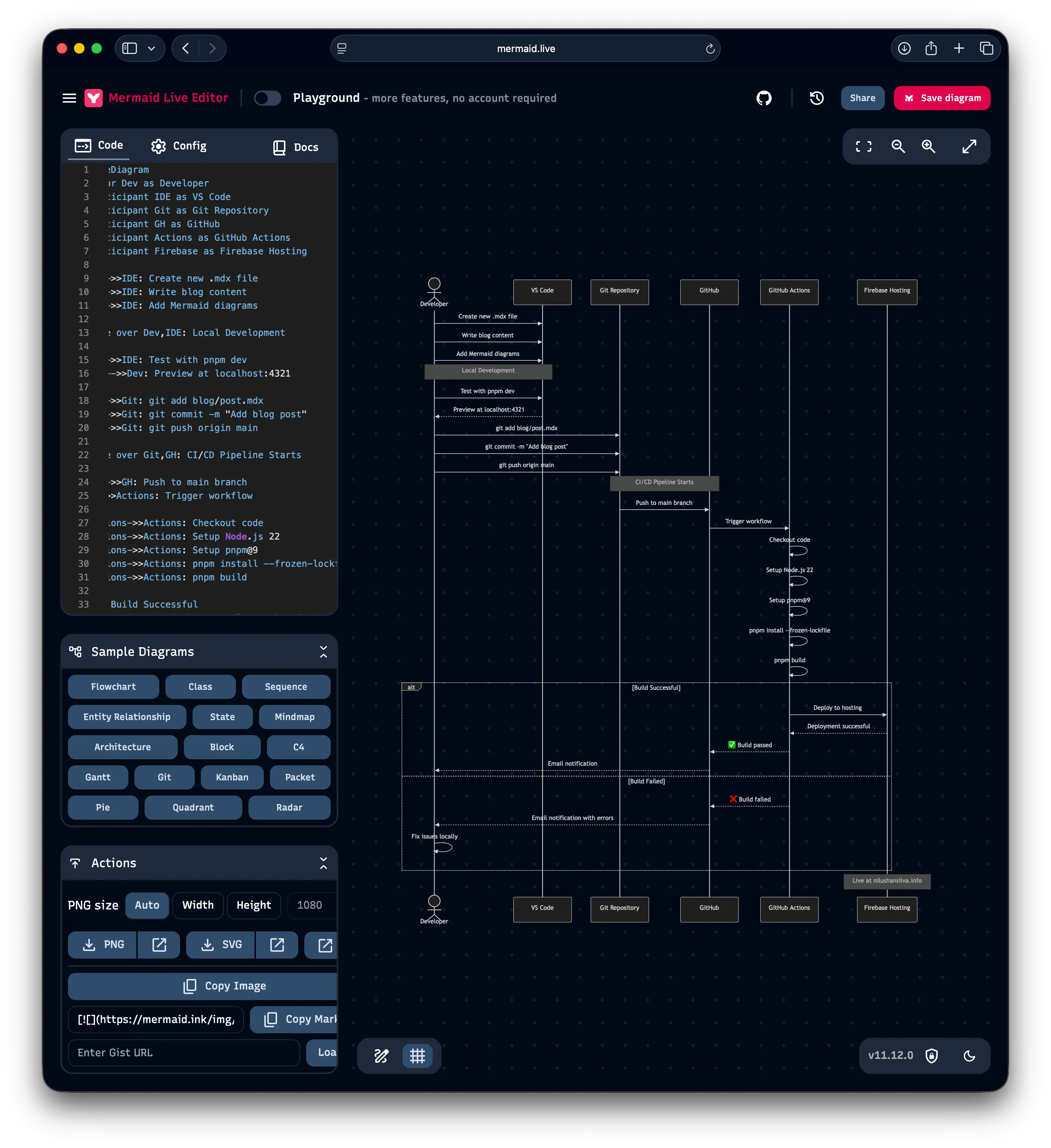
Mastering Mermaid Diagrams for Software Development
A comprehensive guide to using Mermaid diagrams for software development - from sequence diagrams to class diagrams, component diagrams, and more. Learn how to create powerful visual documentation with simple text-based syntax.

In This Article
Use the headings in the article to navigate
Tags
Mermaid is a powerful JavaScript-based diagramming and charting tool that lets you create diagrams using text and code. It’s particularly valuable for software developers because diagrams can be version-controlled, reviewed, and maintained alongside your code.
In this post, I’ll explore the different types of Mermaid diagrams that are most useful for software development, with practical examples you can use immediately.
Why Mermaid?
Before diving into the diagram types, here’s why I love Mermaid:
- Text-based: Store diagrams in version control with your code
- Easy to maintain: Update diagrams by editing text, not dragging boxes
- GitHub-native: Renders automatically in GitHub README files and issues
- No special tools: Works in Markdown, documentation sites, and many IDEs
- Consistent styling: Automatic layout and theming
1. Sequence Diagrams
Sequence diagrams are perfect for visualizing interactions over time. Let’s model the process of creating and deploying a blog post in this very portfolio project.
Creating and Deploying a Blog Post
Rendered Diagram:
sequenceDiagram
actor Dev as Developer
participant IDE as VS Code
participant Git as Git Repository
participant GH as GitHub
participant Actions as GitHub Actions
participant Firebase as Firebase Hosting
Dev->>IDE: Create new .mdx file
Dev->>IDE: Write blog content
Dev->>IDE: Add Mermaid diagrams
Note over Dev,IDE: Local Development
Dev->>IDE: Test with pnpm dev
IDE-->>Dev: Preview at localhost:4321
Dev->>Git: git add blog/post.mdx
Dev->>Git: git commit -m "Add blog post"
Dev->>Git: git push origin main
Note over Git,GH: CI/CD Pipeline Starts
Git->>GH: Push to main branch
GH->>Actions: Trigger workflow
Actions->>Actions: Checkout code
Actions->>Actions: Setup Node.js 22
Actions->>Actions: Setup pnpm@9
Actions->>Actions: pnpm install --frozen-lockfile
Actions->>Actions: pnpm build
alt Build Successful
Actions->>Firebase: Deploy to hosting
Firebase-->>Actions: Deployment successful
Actions-->>GH: ✅ Build passed
GH-->>Dev: Email notification
else Build Failed
Actions-->>GH: ❌ Build failed
GH-->>Dev: Email notification with errors
Dev->>Dev: Fix issues locally
end
Note over Firebase: Live at nilushansilva.info
View Mermaid Code
```mermaid
sequenceDiagram
actor Dev as Developer
participant IDE as VS Code
participant Git as Git Repository
participant GH as GitHub
participant Actions as GitHub Actions
participant Firebase as Firebase Hosting
Dev->>IDE: Create new .mdx file
Dev->>IDE: Write blog content
Dev->>IDE: Add Mermaid diagrams
Note over Dev,IDE: Local Development
Dev->>IDE: Test with pnpm dev
IDE-->>Dev: Preview at localhost:4321
Dev->>Git: git add blog/post.mdx
Dev->>Git: git commit -m "Add blog post"
Dev->>Git: git push origin main
Note over Git,GH: CI/CD Pipeline Starts
Git->>GH: Push to main branch
GH->>Actions: Trigger workflow
Actions->>Actions: Checkout code
Actions->>Actions: Setup Node.js 22
Actions->>Actions: Setup pnpm@9
Actions->>Actions: pnpm install --frozen-lockfile
Actions->>Actions: pnpm build
alt Build Successful
Actions->>Firebase: Deploy to hosting
Firebase-->>Actions: Deployment successful
Actions-->>GH: ✅ Build passed
GH-->>Dev: Email notification
else Build Failed
Actions-->>GH: ❌ Build failed
GH-->>Dev: Email notification with errors
Dev->>Dev: Fix issues locally
end
Note over Firebase: Live at nilushansilva.info
```This sequence diagram shows the complete workflow from creating a blog post to deployment, capturing user interactions, system processes, and conditional logic.
2. Flowcharts
Flowcharts are ideal for showing decision trees and process flows. Here’s how the portfolio site decides which theme to apply:
Theme Selection Logic
Rendered Diagram:
flowchart TD
Start([User visits site]) --> CheckStorage{localStorage
theme exists?}
CheckStorage -->|Yes| LoadTheme[Load saved theme]
CheckStorage -->|No| CheckPreference{Check system
preference}
CheckPreference -->|Dark mode| SetDark[Set dark theme]
CheckPreference -->|Light mode| SetLight[Set light theme]
CheckPreference -->|No preference| SetDefault[Set default theme]
LoadTheme --> ValidateTheme{Is theme
valid?}
ValidateTheme -->|Yes| ApplyTheme[Apply theme to HTML]
ValidateTheme -->|No| SetDefault
SetDark --> ApplyTheme
SetLight --> ApplyTheme
SetDefault --> ApplyTheme
ApplyTheme --> SaveToStorage[Save to localStorage]
SaveToStorage --> DispatchEvent[Dispatch theme-changed event]
DispatchEvent --> End([Render page])
style Start fill:#4ade80
style End fill:#60a5fa
style ApplyTheme fill:#f472b6
View Mermaid Code
```mermaid
flowchart TD
Start([User visits site]) --> CheckStorage{localStorage<br/>theme exists?}
CheckStorage -->|Yes| LoadTheme[Load saved theme]
CheckStorage -->|No| CheckPreference{Check system<br/>preference}
CheckPreference -->|Dark mode| SetDark[Set dark theme]
CheckPreference -->|Light mode| SetLight[Set light theme]
CheckPreference -->|No preference| SetDefault[Set default theme]
LoadTheme --> ValidateTheme{Is theme<br/>valid?}
ValidateTheme -->|Yes| ApplyTheme[Apply theme to HTML]
ValidateTheme -->|No| SetDefault
SetDark --> ApplyTheme
SetLight --> ApplyTheme
SetDefault --> ApplyTheme
ApplyTheme --> SaveToStorage[Save to localStorage]
SaveToStorage --> DispatchEvent[Dispatch theme-changed event]
DispatchEvent --> End([Render page])
style Start fill:#4ade80
style End fill:#60a5fa
style ApplyTheme fill:#f472b6
```3. Class Diagrams
Class diagrams show object-oriented structure. Here’s the type system for the portfolio data:
Portfolio Type System
Rendered Diagram:
classDiagram
class PortfolioData {
+PersonalInfo personal
+Skills skills
+SkillCategory[] skillCategories
+Experience[] experience
+Education education
+Interest[] interests
}
class PersonalInfo {
+string name
+string title
+string tagline
+string email
+string phone
+string location
+SocialLinks social
+string heroSummary
+string[] summary
+number yearsExperience
}
class SocialLinks {
+string github
+string linkedin
+string? twitter
+string? website
}
class SkillCategory {
+string title
+string icon
+string color
+string? description
+string[] skills
}
class Experience {
+string id
+string title
+string company
+string location
+string period
+string type
+string description
+Highlight[] highlights
+string[] technologies
}
class Highlight {
+string title
+string description
}
PortfolioData *-- PersonalInfo
PortfolioData *-- SkillCategory
PortfolioData *-- Experience
PersonalInfo *-- SocialLinks
Experience *-- Highlight
View Mermaid Code
```mermaid
classDiagram
class PortfolioData {
+PersonalInfo personal
+Skills skills
+SkillCategory[] skillCategories
+Experience[] experience
+Education education
+Interest[] interests
}
class PersonalInfo {
+string name
+string title
+string tagline
+string email
+string phone
+string location
+SocialLinks social
+string heroSummary
+string[] summary
+number yearsExperience
}
class SocialLinks {
+string github
+string linkedin
+string? twitter
+string? website
}
class SkillCategory {
+string title
+string icon
+string color
+string? description
+string[] skills
}
class Experience {
+string id
+string title
+string company
+string location
+string period
+string type
+string description
+Highlight[] highlights
+string[] technologies
}
class Highlight {
+string title
+string description
}
PortfolioData *-- PersonalInfo
PortfolioData *-- SkillCategory
PortfolioData *-- Experience
PersonalInfo *-- SocialLinks
Experience *-- Highlight
```This shows the complete type hierarchy of the portfolio data structure, including composition relationships and property types.
4. Component Diagrams
Component diagrams visualize system architecture. Here’s the Astro portfolio architecture:
Astro Portfolio Architecture
Rendered Diagram:
graph TB
subgraph "Client Browser"
HTML[HTML Pages]
CSS[Tailwind CSS]
JS[Client JS]
React[React Islands]
end
subgraph "Build Time"
Pages[Pages/*.astro]
Components[Components/*.astro]
ReactComp[React Components]
Content[Content Collections]
end
subgraph "Styling"
TW[Tailwind v4]
DaisyUI[DaisyUI Themes]
end
subgraph "Deployment"
Build[Astro Build]
Firebase[Firebase Hosting]
end
Pages --> Components
Pages --> Content
Components --> ReactComp
Pages --> TW
Components --> DaisyUI
Build --> Pages
Build --> Firebase
Firebase --> HTML
ReactComp -.->|Hydrated| React
style Build fill:#fbbf24
style Firebase fill:#f87171
style React fill:#60a5fa
View Mermaid Code
```mermaid
graph TB
subgraph "Client Browser"
HTML[HTML Pages]
CSS[Tailwind CSS]
JS[Client JS]
React[React Islands]
end
subgraph "Build Time"
Pages[Pages/*.astro]
Components[Components/*.astro]
ReactComp[React Components]
Content[Content Collections]
end
subgraph "Styling"
TW[Tailwind v4]
DaisyUI[DaisyUI Themes]
end
subgraph "Deployment"
Build[Astro Build]
Firebase[Firebase Hosting]
end
Pages --> Components
Pages --> Content
Components --> ReactComp
Pages --> TW
Components --> DaisyUI
Build --> Pages
Build --> Firebase
Firebase --> HTML
ReactComp -.->|Hydrated| React
style Build fill:#fbbf24
style Firebase fill:#f87171
style React fill:#60a5fa
```5. State Diagrams
State diagrams model state transitions. Here’s the project status lifecycle:
Project Status Lifecycle
Rendered Diagram:
stateDiagram-v2
[*] --> Planned: New project idea
Planned --> InProgress: Start development
Planned --> OnHold: Deprioritized
Planned --> Cancelled: Scope changed
InProgress --> Testing: Feature complete
InProgress --> OnHold: Blocked
InProgress --> Cancelled: Requirements changed
OnHold --> InProgress: Unblocked
OnHold --> Cancelled: No longer viable
Testing --> InProgress: Issues found
Testing --> Completed: All tests pass
Completed --> Deployed: Production release
Deployed --> Maintenance: Post-launch
Maintenance --> Deployed: Updates deployed
Cancelled --> [*]
Deployed --> [*]: Project sunset
note right of InProgress
Active development
Daily commits
end note
View Mermaid Code
```mermaid
stateDiagram-v2
[*] --> Planned: New project idea
Planned --> InProgress: Start development
Planned --> OnHold: Deprioritized
Planned --> Cancelled: Scope changed
InProgress --> Testing: Feature complete
InProgress --> OnHold: Blocked
InProgress --> Cancelled: Requirements changed
OnHold --> InProgress: Unblocked
OnHold --> Cancelled: No longer viable
Testing --> InProgress: Issues found
Testing --> Completed: All tests pass
Completed --> Deployed: Production release
Deployed --> Maintenance: Post-launch
Maintenance --> Deployed: Updates deployed
Cancelled --> [*]
Deployed --> [*]: Project sunset
note right of InProgress
Active development
Daily commits
end note
```6. Entity Relationship Diagrams
ER diagrams are perfect for database schema visualization:
Database Schema for Blog/Portfolio
Rendered Diagram:
erDiagram
USER ||--o{ BLOG_POST : writes
USER ||--o{ PROJECT : creates
BLOG_POST }o--o{ TAG : tagged_with
BLOG_POST }o--|| CATEGORY : belongs_to
PROJECT }o--o{ TECHNOLOGY : uses
USER {
string id PK
string name
string email
string avatar
datetime created_at
}
BLOG_POST {
string id PK
string user_id FK
string title
string slug UK
text content
string category_id FK
boolean featured
datetime publish_date
}
PROJECT {
string id PK
string user_id FK
string title
text description
string period
string status
}
TAG {
string id PK
string name UK
}
CATEGORY {
string id PK
string name UK
}
TECHNOLOGY {
string id PK
string name UK
string icon
}
View Mermaid Code
```mermaid
erDiagram
USER ||--o{ BLOG_POST : writes
USER ||--o{ PROJECT : creates
BLOG_POST }o--o{ TAG : tagged_with
BLOG_POST }o--|| CATEGORY : belongs_to
PROJECT }o--o{ TECHNOLOGY : uses
USER {
string id PK
string name
string email
string avatar
datetime created_at
}
BLOG_POST {
string id PK
string user_id FK
string title
string slug UK
text content
string category_id FK
boolean featured
datetime publish_date
}
PROJECT {
string id PK
string user_id FK
string title
text description
string period
string status
}
TAG {
string id PK
string name UK
}
CATEGORY {
string id PK
string name UK
}
TECHNOLOGY {
string id PK
string name UK
string icon
}
```7. Git Graphs
Visualize your Git branching strategy:
Git Branching Strategy
Rendered Diagram:
gitGraph
commit id: "Initial commit"
commit id: "Add Astro setup"
commit id: "Add Tailwind & DaisyUI"
branch develop
checkout develop
commit id: "Setup content collections"
commit id: "Add blog schema"
branch feature/mermaid-blog
checkout feature/mermaid-blog
commit id: "Create mermaid blog post"
commit id: "Add diagrams"
checkout develop
merge feature/mermaid-blog
commit id: "Test blog post"
checkout main
merge develop tag: "v1.2.0"
checkout develop
branch feature/improvements
checkout feature/improvements
commit id: "Fix dynamic classes"
commit id: "Update color mapping"
checkout develop
merge feature/improvements
checkout main
merge develop tag: "v1.3.0"
View Mermaid Code
```mermaid
gitGraph
commit id: "Initial commit"
commit id: "Add Astro setup"
commit id: "Add Tailwind & DaisyUI"
branch develop
checkout develop
commit id: "Setup content collections"
commit id: "Add blog schema"
branch feature/mermaid-blog
checkout feature/mermaid-blog
commit id: "Create mermaid blog post"
commit id: "Add diagrams"
checkout develop
merge feature/mermaid-blog
commit id: "Test blog post"
checkout main
merge develop tag: "v1.2.0"
checkout develop
branch feature/improvements
checkout feature/improvements
commit id: "Fix dynamic classes"
commit id: "Update color mapping"
checkout develop
merge feature/improvements
checkout main
merge develop tag: "v1.3.0"
```8. Gantt Charts
Project timeline visualization:
Portfolio Development Timeline
Rendered Diagram:
gantt
title Portfolio Development Timeline
dateFormat YYYY-MM-DD
section Planning
Requirements gathering :done, req, 2025-01-01, 7d
Architecture design :done, arch, after req, 5d
section Development
Setup Astro project :done, setup, 2025-01-13, 2d
Implement layouts :done, layouts, after setup, 5d
Build components :done, comps, after layouts, 10d
section Styling
Tailwind integration :done, tw, 2025-01-20, 3d
DaisyUI themes :done, daisy, after tw, 5d
section Content
Portfolio data :done, data, 2025-02-01, 5d
Blog posts :active, blog, after data, 10d
section Deployment
GitHub Actions setup :done, ci, 2025-02-10, 2d
Firebase hosting :done, deploy, after ci, 2d
View Mermaid Code
```mermaid
gantt
title Portfolio Development Timeline
dateFormat YYYY-MM-DD
section Planning
Requirements gathering :done, req, 2025-01-01, 7d
Architecture design :done, arch, after req, 5d
section Development
Setup Astro project :done, setup, 2025-01-13, 2d
Implement layouts :done, layouts, after setup, 5d
Build components :done, comps, after layouts, 10d
section Styling
Tailwind integration :done, tw, 2025-01-20, 3d
DaisyUI themes :done, daisy, after tw, 5d
section Content
Portfolio data :done, data, 2025-02-01, 5d
Blog posts :active, blog, after data, 10d
section Deployment
GitHub Actions setup :done, ci, 2025-02-10, 2d
Firebase hosting :done, deploy, after ci, 2d
```9. Pie Charts
For data visualization:
Technology Stack Distribution
Rendered Diagram:
pie title Technology Stack Distribution
"TypeScript/JavaScript" : 40
"React Components" : 15
"Astro Components" : 25
"CSS/Tailwind" : 12
"MDX Content" : 8
View Mermaid Code
```mermaid
pie title Technology Stack Distribution
"TypeScript/JavaScript" : 40
"React Components" : 15
"Astro Components" : 25
"CSS/Tailwind" : 12
"MDX Content" : 8
```10. Mindmaps
For brainstorming and concept mapping:
Portfolio Architecture Overview
Rendered Diagram:
mindmap
root((Portfolio))
Frontend
Astro 5
React 19
Styling
Tailwind v4
DaisyUI
Content
Blog Posts
Projects
Portfolio Data
Infrastructure
GitHub
Firebase
Build Tools
Features
Multi-theme
SEO
Responsive
View Mermaid Code
```mermaid
mindmap
root((Portfolio))
Frontend
Astro 5
React 19
Styling
Tailwind v4
DaisyUI
Content
Blog Posts
Projects
Portfolio Data
Infrastructure
GitHub
Firebase
Build Tools
Features
Multi-theme
SEO
Responsive
```Best Practices for Mermaid Diagrams
1. Keep It Simple
Don’t try to show everything in one diagram. Break complex systems into multiple focused diagrams.
2. Use Consistent Styling
Apply custom styles to make diagrams more readable and match your brand.
3. Add Notes for Context
Notes help explain non-obvious aspects of your diagrams.
4. Version Control Your Diagrams
Since they’re text, they diff well and can be code-reviewed.
5. Use Subgraphs for Organization
Group related components together for clarity.
Integrating Mermaid in Your Projects
In Markdown (GitHub)
Just use code blocks with mermaid language - GitHub renders them automatically.
In Astro (like this blog)
Use code blocks with mermaid language identifier:
```mermaid
graph TD
A[Start] --> B[End]
```In Documentation Sites
Most modern documentation frameworks (Docusaurus, VuePress, Starlight) support Mermaid out of the box.
In VS Code
Install the “Markdown Preview Mermaid Support” extension for live preview.
Real-World Use Cases
1. API Documentation
Use sequence diagrams to show API request/response flows.
2. System Architecture
Component diagrams for microservices architecture.
3. User Flows
Flowcharts for UX documentation.
4. Database Design
ER diagrams for schema documentation.
5. Project Planning
Gantt charts for sprint planning.
6. State Management
State diagrams for Redux/Zustand flows.
Conclusion
Mermaid diagrams are an invaluable tool for software developers. They allow you to:
- Document as you code - No context switching to diagramming tools
- Review diagrams in PRs - See exactly what changed
- Keep docs in sync - Update diagrams with code changes
- Onboard faster - Visual documentation is easier to understand
- Communicate clearly - A diagram is worth a thousand lines of code
The best part? You can start using Mermaid today. Just add code blocks with the mermaid language identifier to your Markdown files!
Resources
- Mermaid Official Documentation
- Mermaid Live Editor - Test your diagrams online
- VS Code Extension
- GitHub Mermaid Support
Happy diagramming!
Have you used Mermaid in your projects? What’s your favorite diagram type? Let me know on GitHub!
